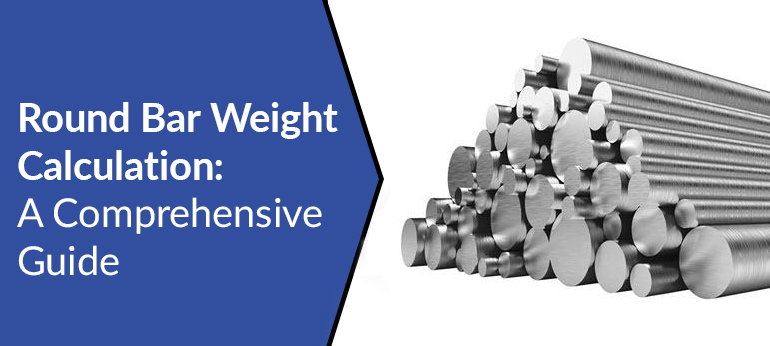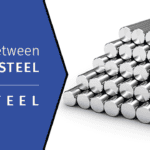Welcome to the comprehensive guide on round bar weight calculator. Whether you are a metallurgist, engineer, or simply curious about the weight of round bars, this article will provide you with all the necessary information. Knowing the weight of a round bar is crucial in various industries, including construction, manufacturing, and engineering. We’ll explore different methods, formulas, and tips to calculate the weight of round bars accurately. By the end of this guide, you’ll have the expertise to handle any round bar weight calculation with ease and understand its implications on the round bar price per kg.
Different Method of Round Bar Weight Calculator
Calculating the weight of a round bar can be done using various approaches, each suited for specific scenarios. Below, we delve into different methods, each offering a unique Round Bar Weight Formula to determine the weight.
Method 1: Round Bar Weight Formula Using the Diameter and Length
The most straightforward method to calculate the weight of a round bar involves knowing its diameter and length. Follow these steps to compute the weight:
Measure the diameter (d) of the round bar in inches.
Measure the length (L) of the round bar in feet.
Apply the formula: weight = 0.00617 * d^2 * L.
Example:
Round bar diameter (d) = 0.5 inches
Round bar length (L) = 6 feet
Weight = 0.00617 * (0.5)^2 * 6 = 0.00617 * 0.25 * 6 = 0.09225 pounds.
Method 2: Round Bar Weight Formula Using Specific Material Density
In some cases, the material density is readily available, making the calculation more straightforward. The formula for this method is:
Find the density (ρ) of the material in pounds per cubic inch.
Measure the diameter (d) of the round bar in inches.
Measure the length (L) of the round bar in feet.
Use the formula: weight = π * (d/2)^2 * L * ρ.
Example:
Material density (ρ) = 0.283 pounds per cubic inch
Round bar diameter (d) = 1 inch
Round bar length (L) = 10 feet
Weight = π * (1/2)^2 * 10 * 0.283 ≈ 1.404 pounds.
Method 3: Round Bar Weight Formula With Material Volume
For certain materials, the volume calculation can provide an alternative method. Follow these steps:
Measure the diameter (d) of the round bar in inches.
Measure the length (L) of the round bar in feet.
Use the formula: volume = π * (d/2)^2 * L.
Find the material density (ρ) in pounds per cubic inch.
Calculate the weight = volume * ρ.
Example:
Round bar diameter (d) = 0.75 inches
Round bar length (L) = 8 feet
Material density (ρ) = 0.289 pounds per cubic inch
Volume = π * (0.75/2)^2 * 8 ≈ 1.767 cubic inches
Weight ≈ 1.767 * 0.289 ≈ 0.511 pounds.
Method 4: Round Bar Weight Formula Using an Online Calculator
If you prefer a more convenient option, many online calculators can instantly determine the weight of round bars. Simply input the required dimensions, and the calculator will provide the result.
Factors Affecting Round Bar Weight
Several factors influence the weight of a round bar. It’s essential to consider these factors when working on weight calculations.
Material Type
Different materials have varying densities, affecting the weight of round bars and subsequently impacting the round bar price per kg. For instance, steel has a higher density than aluminum, resulting in heavier steel bars for the same dimensions.
Diameter and Length
As expected, larger diameter and longer round bars will weigh more than smaller ones of the same material, leading to differences in the round bar price per kg.
Manufacturing Tolerances
Manufacturing processes may introduce slight variations in the diameter and length, impacting the final weight of the round bar.
Alloying Elements
For alloys, the presence of additional elements may alter the material’s density, affecting the weight.
Temperature
Temperature can cause expansion or contraction, leading to slight variations in weight, albeit minimal.
Round Bar Weight Chart
The following table lists the theoretical weight of 1-310mm round bar in kg/m
If your steel size is not in the table below, you can use our steel weight calculator to calculate online.
| Grade (mm) | Theoretical weight (kg/m) |
|---|---|
| 5.5 | 0.186 |
| 6 | 0.222 |
| 6.5 | 0.26 |
| 7 | 0.302 |
| 8 | 0.395 |
| 9 | 0.499 |
| 10 | 0.617 |
| 11 | 0.746 |
| 12 | 0.888 |
| 13 | 1.04 |
| 14 | 1.21 |
| 15 | 1.39 |
| 16 | 1.58 |
| 17 | 1.78 |
| 18 | 2 |
| 19 | 2.23 |
| 20 | 2.47 |
| 21 | 2.72 |
| 22 | 2.98 |
| 23 | 3.26 |
| 24 | 3.55 |
| 25 | 3.85 |
| 26 | 4.17 |
| 27 | 4.49 |
| 28 | 4.83 |
| 29 | 5.18 |
| 30 | 5.55 |
| 31 | 5.92 |
| 32 | 6.31 |
| 33 | 6.71 |
| 34 | 7.13 |
| 35 | 7.55 |
| 36 | 7.99 |
| 38 | 8.9 |
| 40 | 9.86 |
| 42 | 10.9 |
| 45 | 12.5 |
| 48 | 14.2 |
| 50 | 15.4 |
| 53 | 17.3 |
| 55 | 18.6 |
| 56 | 19.3 |
| 58 | 20.7 |
| 60 | 22.2 |
| 63 | 24.5 |
| 65 | 26 |
| 68 | 28.5 |
| 70 | 30.2 |
| 75 | 34.7 |
| 80 | 39.5 |
| 85 | 44.5 |
| 90 | 49.9 |
| 95 | 55.6 |
| 100 | 61.7 |
| 105 | 68 |
| 110 | 74.6 |
| 115 | 81.5 |
| 120 | 88.8 |
| 125 | 96.3 |
| 130 | 104 |
| 135 | 112 |
| 140 | 121 |
| 145 | 130 |
| 150 | 139 |
| 155 | 148 |
| 160 | 158 |
| 165 | 168 |
| 170 | 178 |
| 180 | 200 |
| 190 | 223 |
| 200 | 247 |
| 210 | 272 |
| 220 | 298 |
| 250 | 385 |
| 260 | 417 |
| 270 | 449 |
| 280 | 483 |
| 290 | 518 |
| 300 | 555 |
| 310 | 592 |
HR Round Bar Weight Chart
| No. | Item | Unit | Weight |
|---|---|---|---|
| 1 | Φ5.5 | kg/m | 0.186 |
| 2 | Φ6 | kg/m | 0.222 |
| 3 | Φ6.5 | kg/m | 0.26 |
| 4 | Φ7 | kg/m | 0.302 |
| 5 | Φ8 | kg/m | 0.395 |
| 6 | Φ9 | kg/m | 0.499 |
| 7 | Φ10 | kg/m | 0.617 |
| 8 | Φ11 | kg/m | 0.476 |
| 9 | Φ12 | kg/m | 0.888 |
| 10 | Φ13 | kg/m | 1.04 |
| 11 | Φ14 | kg/m | 1.21 |
| 12 | Φ15 | kg/m | 1.39 |
| 13 | Φ16 | kg/m | 1.58 |
| 14 | Φ17 | kg/m | 1.78 |
| 15 | Φ18 | kg/m | 2 |
| 16 | Φ19 | kg/m | 2.23 |
Frequently Asked Questions (FAQs)
Is the weight of a round bar the same as its mass?
Yes, in everyday applications, weight and mass are often used interchangeably, referring to the amount of matter in an object.
What is the standard unit for measuring round bar weight?
The standard unit used to measure round bar weight is pounds (lbs) or kilograms (kg), depending on the region.
Can I use the same formula to calculate the weight of a round tube?
No, round tubes have a different formula for weight calculation, considering their hollow nature.
Are there any safety precautions when dealing with heavy round bars?
Yes, always wear appropriate personal protective equipment (PPE) and handle heavy bars with care to prevent accidents.
How accurate are online calculators for round bar weight?
Online calculators are generally reliable and provide accurate results for most applications.
What is the significance of calculating round bar weight in specific industries?
Accurate weight calculations are vital in engineering, construction, and manufacturing for material procurement and structural integrity purposes. It also influences the round bar price per kg, impacting cost estimates.
Conclusion
With this complete comprehensive guide on round bar weight calculation. Now armed with different methods and formulas, you can confidently calculate the weight of round bars for various applications. Remember to consider the material type, diameter, length, manufacturing tolerances, alloying elements, and temperature when conducting weight calculations. Whether you’re designing structures or working on engineering projects, knowing the weight of round bars is a fundamental skill that will serve you well.



